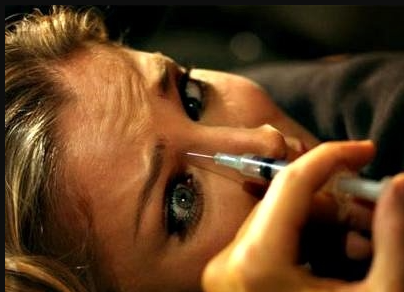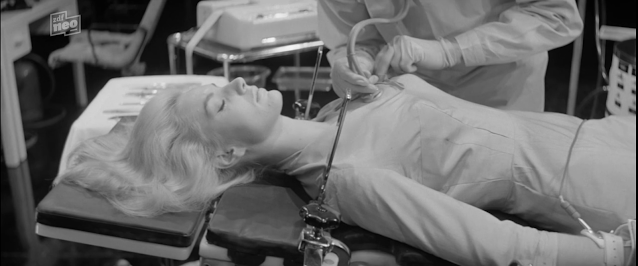I've been asked about my personal top 10 genre Films, the ones I've always come back to throughout my life, that I purchased in every format from VHS to dvd, BD, UHD and where I really tried to see them with an audience in a cinema. I do not include the usual suspects, those films that everybody knows, basically all american major studio-productions although of course I did like "Watchmen" very much.
I have included further suggestions if you liked one particular movie. If you got any additional suggestions, please be so kind to leave a comment.
10. Under the Silver Lake 2018 (USA)
Directed by the man that brought you "It follows", this is an ambitious, thought-provoking neo-noir conspiracy-theory thriller dedicated to Alfred Hichcock and Brian De Palma. From the first frame ("Beware of the Dog Killer?) on we get transformed to Vertigo-Land with a heavy dose of Body-Double gore and drifting boy meets girl, loves girl, loses girl. There is so much to see and hear and think about in this very well made movie that demands repeated viewings. And absolutely rewards them. What happened to the girl? What happened to the celebrity? What's beneath the Silver Lake? Who is the unshaved Owl-Woman super-villain assassin? Why does all music sound alike today? Will Sam keep his flat? And who the Hell is the Dog-Killer - the last question you have to find out yourself using the clues given to you throughout the movie -- yes it's that kind of film.
There are actually numerous feature-length documentaries out there trying to decode the movie (but that would spoil the fun) which tackles the same (and sadly true) topic as "Short Night of the Glass Dolls".
I've shown this to numerous people and they do not get it. To me, this is everything. And a goddamn good movie. And - of course - in the meantime became the subject of a conspiracy theory on it's own. The original soundtrack is phenomenal. btw.
Here's the official trailer:
https://www.youtube.com/watch?v=mwgUesU1pz4
Further viewing from here : Body Double, Vertigo, Lodge 49, Short Night of the Glass Dolls
9. Die Hölle-Inferno 2017 (AUSTRIA/GERMANY)
Directed by an oscar-winning austrian guy, this is as much a throwback to the giallo-genre from across
the border as it is a a social study of vienna's immigré society and a poliscetti all in one. Immaculate in direction, design and acting (Tobias Moretti always was one of my favourite actors), the real stand-out is the stellar performance by Violetta Schulawrow who is the toughest stalker-victim you have ever seen. There is very little not to like about this violent, action-packed movie about a manic killer who skins prostitutes (you've been warned!).
Nobody knows this movie, but everybody -EVERYBODY - is completely on my side after having watched it. Known as "Cold Hell" in Englishspeakingcountry.
The trailer:
https://www.youtube.com/watch?v=iBcDdCwRMQQ
Further viewing from here: Das finstere Tal
8. I, Madman 1989 (USA)
Directed by the man who had a minor success with "The Gate" and got enough money to produce this "opus magnum" and who sadly was not given any cash to direct decent things any more from then on. Here, he throws it all at your face. Every nerd's dreamgirl is huge into used pulp fiction novels and stumbles across a novel that makes her investigate the author's life, only to find out that he lives inside the books she's reading as he is investigating her.
Again this film has everything, a very solid 80is direction a likable and hot actress, used booksstores, secret findings in the attic and a killer that is very, very original and very disturbing. The money is well spent on flashbacks to the 1950s (the area the books were written), giving you a welcome feel of nostalgia.
Sometimes hard to come by, the HD BD transfer is a revelation.
https://www.youtube.com/watch?v=3CThhGkTY4Y
Further viewing from here: Spider Labyrinth, Dreamscape,
The Sect, The Caller (Malcom MacDowell)
7. Demons 1985 (ITA)
Directed by the son of the man who inspired my favourite director, this has 1985, Berlin, The Metropol, Punk, Post-Punk, Onibaba, Nostradamus, Movie-in-Movie and so much, oh so much Gore.
It's like they checked every box I would have put on a wish-list for a good movie. And that it is. It moves at a brisk pace, has a lot of genre inside references (the building, the mask!, the helicopter!!), comments about the Berlin Wall and the cold war situation, ok acting and terrific gore. The few musical pieces Claudio Simonetti threw in are perfect and I got them all on the original LP and 12" Maxidisc.
The story: Preview audience of an obscure 80ies slasher movie are demonised by a mask? the movie? the movie theatre? a plague? Who knows. Who cares. In the end, they tear this place apart. Like, totally...
The HDR 4K release brought tears to my eyes and endless enjoyment.
And am I the only one who actually wants to see the movie they project in the theatre here? At least a rough-cut of all the existing scenes??? Petition plase. And no: "Graveyard Disturbance" by Lamberto Bava has basically the same plot but being a cheap TV-production comes not even close. The title song, though is a banger and should have been in "Demons". You can listen to it here. - And yes, they did use it in "Demons 3" aka "The Church".
Avoid the sequel. I mean, avoid it after you've seen the first one. Although it is a solid movie on its own it is just three complete steps down in every department from the original one.
https://www.youtube.com/watch?v=_59ssegTKr4
Further viewing from here: One Cut of the Dead, Blood red Sky
6. Raisins de la Mort 1981 (FR)
Directed by the man who filmed this shot:
Brigitte Lahaye In the night, steaming, with two doberman dogs in midst of a village full of zombies. That's it. You don't need more to convince me that this is a masterpiece for eternity.
Even Lahaye admits that this is the image everyone will remember her for. To me this came totally unannounced while I watched an obscure movie called "Torture Mill of the Captured Women" (this is how it was called here) as 18-year old in a grindhouse with the copy shown being so worn out that it was an experience on it's own.
This is of course not about a mill or captured women, more about a vinyard (which of course might have a grape press which might be called a mill in the furthest of all associations - but that does not show up in the movie once!) and crucified women (well there is a sort-of-held-captive woman in a farmhouse... not a mill). And they were killed by men who drank the wine they themselves had polluted with pesticides. This is so socially relevant and politically correct that it should be obligatory to show in all college classes. Petition please. The students will not complain. Maybe their parents, but only because they were not allowed in.
And it is directed by Jean Rollin. This film started my fascination with this little french man. And how worthwile was that!
This movie actually has an ugly look to it that totally captures how these countrysides really look like in autumn. I've been there. So thumbs up for authenticity.
The movie has been ridiculed as a tax-shelter throwaway, lacking the lyricism of Jean Rollin's other movies. But really this is well thought out. The scene described above is direct hommage to Barbara Steele in "La Mascera del Demonio", I bet you did not know that :-)!
 |
| Legendary Brigitte (SFW) |
 |
| Legendary Barbara |
Brigitte herself remembers the shooting like this:
"This legendary night, temperatures were multiple degrees below the freezing point. Thus the camera stopped rolling again and again as the motor could not work the reels anymore..as I was standing there, undressed...and everybody was staring at me so strangely." I bet they were. As was me.
https://www.youtube.com/watch?v=Z82_93Nh24U
Further viewing from here: All Jean Rollin movies and
The House with laughing windows
5. Belfegor 1965 (FR)

A french 4-part TV-movie series. Yes. And the eeriest thing ever to be shot on film. I watched it first when I was 6 years old and it scarred me for life. When it first came out on french DVD 30 years later I was virtually shaking to watch it again and still it was so menacing. Since then I showed it to numerous people and all have the same reaction "You were shown this on TV when you were a child??? OMG". It is true and I stand by my word, this is some of the eeriest things you have ever witnessed. So what is it about: Well, guards at the Louvre Museum in Paris are murdered by the Ghost of an ancient Babylonian God. The tension and fear in this stark black and white film is unbearable, even when we get to see "Belfegor" itself. I kid you not. This is an excercise in style and a very, very nice throwback to 60ies culture. Besides this, this is very well written and deals with ancient alchemy, ghosts, books and paperslips in tins. I have no idea how someone in englishlanguagecountry can get a hand on a dubbed or even subbed version, but if you are into 60ies eerie bw movies, this is a must. And being 360 minutes long, you really get the full treatment.
Lars von Trier has stated that this series inspired him to "Kingdom".
It stars chansonette Juliette Greco, and in lack of a movie poster (it was a TV-series after all), this is the original soundtrack. The serial was released on a near-perfect french dvd and two not-so-perfect german dvd's, all of them without english subs/dubs.
Belfegor was originally filmed in 1927 as a silent 12 chapter serial (which is available in a very good restored version) and was sequelled in the 2000s (both versions are not very good, though).
https://www.youtube.com/watch?v=mXqZo4vgFp8
Further viewing from here: Les Compagnons d'Eleusis,
Lodge 49, Le Collectionneur des Cerveaux, Kingdom (TV-Series)
4. The Innocents 1961 (UK)
Even older is this movie that is hauntingly beautiful and completely unnerving. It is one of the great classics of the haunted-house genre, but very often overlooked. To the thinking spectator this movie hits like a hammer with his codings on sexuality and morality, constructivism and objectivism. It is a very, very saddening movie that demands repeated viewings to be fully understood. But when, the message hits you even harder. As time goes by, I start to hesitate to watch this movie as it unnerves me too much. Have a nice sleep after that.
This the best-crafted and polished movie on this list.
When it was released it was advertised as "the first haunted house movie for adults". Back then "adults" meant "educated" not "copulating".
If you have not seen it, I won't spoil the movie to you, but the premise is that a female teacher is hired to teach two children, with the boy being far too adolescent for his age.
https://www.youtube.com/watch?v=aOsF0S65RR0
Further viewing: The Spiral Staircase, Bunny Lake is missing
3. The Great Silence 1968 (ITA/FRA)
Kinski is the killer/bounty hunter. JL Tritignant is the silent mercenary hired to protect. A snow western. I love snow westerns. I love spaghetti-snow-westerns even more (is there actually another one out there?). And seeing Kinski always gives me the creeps (as it rightfully should - he's testament to the knowledge that if we let freaks entertain us, we should not look too deeply under their surfaces - after all, they are freaks).
This is one bastard son-of-a-bitch of a movie, nihilistic, brutal. A movie to end all movies. It did not make sense to produce westerns after that one. If you haven't got it by now that this world is an evil place full of evil humans and that the good ones are just sheep ready to be slaughterd, this movie will undeniably prove it to you.
And director Damiano actually calls it: after this movie, there is only silence, numbness and desperation. The silent mercenary, the silence produced by the snow, the silence of the victims, the silence after the last shot was fired and our silence as an audience. This is a deeply political movie.
Essential.
https://www.youtube.com/watch?v=PmEz3kdDevA
Further viewing: Death Sentence (Western)
2. The Killer 1989 (HK)
The best movie John Woo has ever directed, this one is so well constructed and choreographed and as I have to sort the movies in this list, this is the one dearest to me. Bro films always enchant me and this is the ultimate one.
A killer is hired for a hit on a mob-boss but injures the bar singer who loses her eyesight due to his shot. He decides to take care of her but gets entangled in a big-time order his best buddy has arranged for him. The procedure is standard, the design immaculate.
The final shoot-out in the chapel is too beautiful to be believed.
https://www.youtube.com/watch?v=Cdxehm0NxkU
Further viewing: The Man who would be king, Internal Affairs
1. Tenebre 1981 (ITA)
Destiny brought me to this movie and every 2 to 3 years a new edition is published and I have to buy it and watch the movie and everytime I get excited. I discover new things and to me this is the finest
a) Argento
b) Giallo
c) Genre Film
ever. When I was 17 I had a stop-over at the main station in K-town. In the bookstore you could get american newspapers and there I discovered a mag called "Fangoria" and I bought it. Man. Full of strange and unknown films and an interview with a man called "Dario Argento". He was talking about his new film and how he used special film material on his movies and so on. A year later the movie premieres at my local cinema right after my 18th birthday. I took the bus for a saturday afternoown showing and sat there with 3 dudes to watch it in uncut glory. I had never seen/heard/witnessed anything like this. Goblin soundtrack, Camera, Gore, Tension, Fear, Sex. Everything was there. And it still is a great movie.
Ah, the story: Well, american bookauthor comes to Rome to find out his crime-novels murders are being copied in real-life. The script is - if you pay attention - very tightly plotted and everything makes sense in the end. Don't be fooled into "This is a cheap italian slasher film". This is Argento's statement on himself, his art, the media and the audience. The last Argento movie to make it big in Italy (
#16 in the Box-Office year-end chart), this is his finest achievement and most personal film. Forget Nicollodi's mumbo-jumbo technicolor fairy tales. This one the the real Argento.
The film was prohibited from being shown on TV in Italy (not because of gore&sex - they do not care there - the descendents of the joyous romans (did you see Caligula btw???)) as one actress became the wife of the italian president.
Further viewing: Perfect Blue, Deep Red, Opera, NonHoSonno
















































































